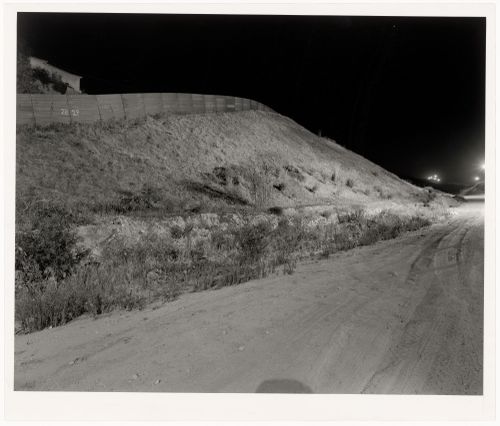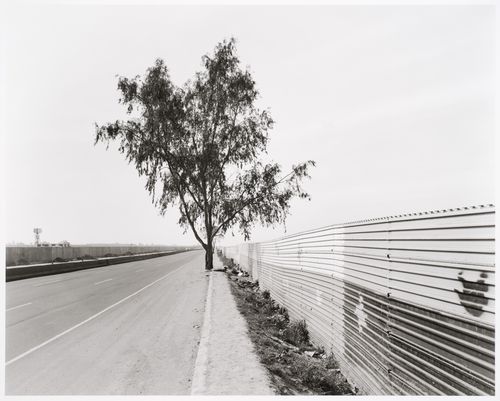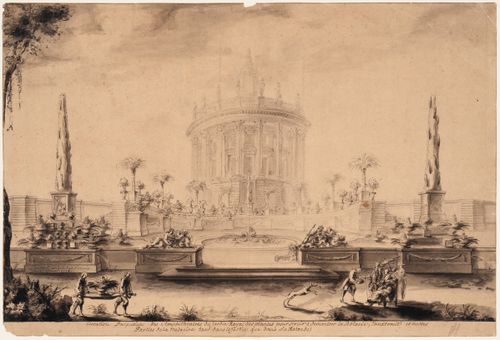PH1997:0062
Description:
- The series "Running Fence 1997" focuses "on the first 14 miles of the border fence that separates the United States and Mexico, beginning at the Pacific Ocean and ending in the Otay Mountains.... [It] analyzes the "idea" of the border and explores its iconography, the border being a subject that is of extreme importance to the public as the world proceeds towards greater globalization. [Geoffrey] James has written of the project: "[The border fence] was built by the US Army Corps of Engineers in 1994, out of recycled metal landing strip - the most visible symbol of what is known as Operation Gatekeeper. Because the steel sheets are placed in the ground so that their ridges run horizontally, a man can hop over the fence with ease; and no Mexican child ever seems to be impeded from retrieving a soccer ball from US territory. The real barrier to illegal immigration from Mexico into the USA is less visible: hundreds of buried sensors linked to a central computer, nightscopes, helicopters and Border Patrol Agents in white Broncos."" (Evans).
architecture, ingénierie
1997
Partial night view of the United States-Mexico border fence from the United States side, San Diego County, California, United States, and Tijuana, Baja California, Mexico
Actions:
PH1997:0062
Description:
- The series "Running Fence 1997" focuses "on the first 14 miles of the border fence that separates the United States and Mexico, beginning at the Pacific Ocean and ending in the Otay Mountains.... [It] analyzes the "idea" of the border and explores its iconography, the border being a subject that is of extreme importance to the public as the world proceeds towards greater globalization. [Geoffrey] James has written of the project: "[The border fence] was built by the US Army Corps of Engineers in 1994, out of recycled metal landing strip - the most visible symbol of what is known as Operation Gatekeeper. Because the steel sheets are placed in the ground so that their ridges run horizontally, a man can hop over the fence with ease; and no Mexican child ever seems to be impeded from retrieving a soccer ball from US territory. The real barrier to illegal immigration from Mexico into the USA is less visible: hundreds of buried sensors linked to a central computer, nightscopes, helicopters and Border Patrol Agents in white Broncos."" (Evans).
architecture, ingénierie
PH1997:0063
Description:
- The series "Running Fence 1997" focuses "on the first 14 miles of the border fence that separates the United States and Mexico, beginning at the Pacific Ocean and ending in the Otay Mountains.... [It] analyzes the "idea" of the border and explores its iconography, the border being a subject that is of extreme importance to the public as the world proceeds towards greater globalization. [Geoffrey] James has written of the project: "[The border fence] was built by the US Army Corps of Engineers in 1994, out of recycled metal landing strip - the most visible symbol of what is known as Operation Gatekeeper. Because the steel sheets are placed in the ground so that their ridges run horizontally, a man can hop over the fence with ease; and no Mexican child ever seems to be impeded from retrieving a soccer ball from US territory. The real barrier to illegal immigration from Mexico into the USA is less visible: hundreds of buried sensors linked to a central computer, nightscopes, helicopters and Border Patrol Agents in white Broncos."" (Evans).
architecture, ingénierie
1997
View along a highway leading to the airport in Tijuana, Baja California, Mexico, showing a partial view of the United States-Mexico border fence
Actions:
PH1997:0063
Description:
- The series "Running Fence 1997" focuses "on the first 14 miles of the border fence that separates the United States and Mexico, beginning at the Pacific Ocean and ending in the Otay Mountains.... [It] analyzes the "idea" of the border and explores its iconography, the border being a subject that is of extreme importance to the public as the world proceeds towards greater globalization. [Geoffrey] James has written of the project: "[The border fence] was built by the US Army Corps of Engineers in 1994, out of recycled metal landing strip - the most visible symbol of what is known as Operation Gatekeeper. Because the steel sheets are placed in the ground so that their ridges run horizontally, a man can hop over the fence with ease; and no Mexican child ever seems to be impeded from retrieving a soccer ball from US territory. The real barrier to illegal immigration from Mexico into the USA is less visible: hundreds of buried sensors linked to a central computer, nightscopes, helicopters and Border Patrol Agents in white Broncos."" (Evans).
architecture, ingénierie
dessins, documents textuels, né numérique, photographies
AP181.S1.011
Description:
Original directory name: "11_Publikation". File consists chiefly of presentations (Powerpoint, PDF and InDesign files), organized by date and topic such as the double cone, the interior design, the restaurants, the lighting, etc. Often, drawings or images used in the presentations are kept within the same directory. In some instances Adobe InDesign files might have dependencies on those drawings and images, so duplicates were not removed. Presentations seemed to have served various purposes such as showing design proposals or the construction’s progress. Some system files, true type font and photographs predate the BMW Welt project. File notably contains the film commissioned by COOP HIMMELB(L)AU to Imaginary Forces in order to show BMW the magnitude of the project of BMW Welt. A six meter long model was created for this purpose. The film was shown to the client on a 8 x 10 meter screen. Film is in directory "o_Präsentation\050407_INNENAUSBAU" and there are also preliminary and alternate versions in other directories in this file. Most common file formats: JPEG File Interchange Format, Acrobat PDF 1.4 - Portable Document Format, Adobe Illustrator, Encapsulated PostScript File Format, Acrobat PDF 1.5 - Portable Document Format
1995-2007
Presentations, BMW Welt, Munich
Actions:
AP181.S1.011
Description:
Original directory name: "11_Publikation". File consists chiefly of presentations (Powerpoint, PDF and InDesign files), organized by date and topic such as the double cone, the interior design, the restaurants, the lighting, etc. Often, drawings or images used in the presentations are kept within the same directory. In some instances Adobe InDesign files might have dependencies on those drawings and images, so duplicates were not removed. Presentations seemed to have served various purposes such as showing design proposals or the construction’s progress. Some system files, true type font and photographs predate the BMW Welt project. File notably contains the film commissioned by COOP HIMMELB(L)AU to Imaginary Forces in order to show BMW the magnitude of the project of BMW Welt. A six meter long model was created for this purpose. The film was shown to the client on a 8 x 10 meter screen. Film is in directory "o_Präsentation\050407_INNENAUSBAU" and there are also preliminary and alternate versions in other directories in this file. Most common file formats: JPEG File Interchange Format, Acrobat PDF 1.4 - Portable Document Format, Adobe Illustrator, Encapsulated PostScript File Format, Acrobat PDF 1.5 - Portable Document Format
dessins, documents textuels, né numérique, photographies
1995-2007
DR1962:0006
Description:
- DR1962:0006 shows a perspective view of a portion of a formal garden terrace laid out symmetrically before a three-storey circular structure. The terrace, which is approached on axis by two steps flanked by sculpted river allegories, is centred on a circular basin and backed by a wall surmounted by potted plants, mostly palm trees and pineapple plants; the middle section of the rear wall curves back concentric to the terrace basin. Beyond the terrace wall and on line with the steps and basin rises the circular structure. With its Corinthian peristyle, this structure has the form of an antique circular temple, such as the so-called "Temple of Vesta" at Tivoli (first century B.C.). Unlike such classical models, however, the columns of the peristyle are set on tall rusticated pedestals that flare outward as they descend to the ground, the entablature carries a balustrade topped by a series of sculpted figures, and the whole is crowned by a tall, slender lantern (although no dome is visible). Within the peristyle, the inner wall is opened regularly by two storeys of windows, each with its own frame and pediment. The overall effect of this structure is not dissimilar to that of James Gibb's Radcliffe Camera, Oxford (1739-49). - In the foreground of DR1962:0006 appear two groups of figures: that on the left consisting of two gardeners carrying a potted pineapple plant, and that on the right consisting of a seated woman attended by a man, a woman (the latter shading her mistress with a parasol), and a figure, apparently a physician, who offers the seated woman a bowl of fruit.
architecture, architecture de paysage
ca. 1744
Project for a medical amphitheatre in the Jardin royal des plantes, Paris
Actions:
DR1962:0006
Description:
- DR1962:0006 shows a perspective view of a portion of a formal garden terrace laid out symmetrically before a three-storey circular structure. The terrace, which is approached on axis by two steps flanked by sculpted river allegories, is centred on a circular basin and backed by a wall surmounted by potted plants, mostly palm trees and pineapple plants; the middle section of the rear wall curves back concentric to the terrace basin. Beyond the terrace wall and on line with the steps and basin rises the circular structure. With its Corinthian peristyle, this structure has the form of an antique circular temple, such as the so-called "Temple of Vesta" at Tivoli (first century B.C.). Unlike such classical models, however, the columns of the peristyle are set on tall rusticated pedestals that flare outward as they descend to the ground, the entablature carries a balustrade topped by a series of sculpted figures, and the whole is crowned by a tall, slender lantern (although no dome is visible). Within the peristyle, the inner wall is opened regularly by two storeys of windows, each with its own frame and pediment. The overall effect of this structure is not dissimilar to that of James Gibb's Radcliffe Camera, Oxford (1739-49). - In the foreground of DR1962:0006 appear two groups of figures: that on the left consisting of two gardeners carrying a potted pineapple plant, and that on the right consisting of a seated woman attended by a man, a woman (the latter shading her mistress with a parasol), and a figure, apparently a physician, who offers the seated woman a bowl of fruit.
architecture, architecture de paysage
archives
Niveau de description archivistique:
Fonds
Fonds John Bird
AP108
Résumé:
The John Bird fonds documents the professional practice of the Westmount-based architect, and includes drawings and photographs of 24 architectural projects carried out in and around Montréal, Québec between 1954 and 1992. The fonds also contains a number of published articles that document John Bird's professional activities. Key projects that are represented include the Canadian Technical Tape Building, St. Laurent (1955-1963), Saint Gabriel's Church, Montréal (1959-1960), and Saint John Brebeuf Church, Lasalle (1962-1966). The fonds also includes numerous projects for Toronto-Dominion Bank buildings (1959-1992) as well as residential designs completed for the Central Mortgage and Housing Corporation (1956-1969).
1942 - 1992
Fonds John Bird
Actions:
AP108
Résumé:
The John Bird fonds documents the professional practice of the Westmount-based architect, and includes drawings and photographs of 24 architectural projects carried out in and around Montréal, Québec between 1954 and 1992. The fonds also contains a number of published articles that document John Bird's professional activities. Key projects that are represented include the Canadian Technical Tape Building, St. Laurent (1955-1963), Saint Gabriel's Church, Montréal (1959-1960), and Saint John Brebeuf Church, Lasalle (1962-1966). The fonds also includes numerous projects for Toronto-Dominion Bank buildings (1959-1992) as well as residential designs completed for the Central Mortgage and Housing Corporation (1956-1969).
archives
Niveau de description archivistique:
Fonds
1942 - 1992
archives
Niveau de description archivistique:
Fonds
Fonds Ross & Macdonald
AP013
Résumé:
The Ross & Macdonald fonds is comprised of documents concerning the work of six successive architectural firms: Ross & MacFarlane (1905-1912), Ross & Macdonald (1913-1944), Ross & Ross (1944-1946), Ross, Patterson, Townsend & Heughan (1946-1950), Ross, Patterson, Townsend & Fish (1950-1958), and Ross, Fish, Duschenes & Barrett (1958-1976). The greatest concentration of work was produced in Montreal where each of the firms maintained their head office, but there were also a large number of works executed in New Brunswick and Nova Scotia. The fonds contains 27 884 drawings (24 294 originals plus 3 590 reproductions), 236 photographs, and 18.6 metres of textual documents.
1902-1982
Fonds Ross & Macdonald
Actions:
AP013
Résumé:
The Ross & Macdonald fonds is comprised of documents concerning the work of six successive architectural firms: Ross & MacFarlane (1905-1912), Ross & Macdonald (1913-1944), Ross & Ross (1944-1946), Ross, Patterson, Townsend & Heughan (1946-1950), Ross, Patterson, Townsend & Fish (1950-1958), and Ross, Fish, Duschenes & Barrett (1958-1976). The greatest concentration of work was produced in Montreal where each of the firms maintained their head office, but there were also a large number of works executed in New Brunswick and Nova Scotia. The fonds contains 27 884 drawings (24 294 originals plus 3 590 reproductions), 236 photographs, and 18.6 metres of textual documents.
archives
Niveau de description archivistique:
Fonds
1902-1982
livres
SO - IL : Amant.
Description:
75 pages : illustrations (chiefly color) ; 29 cm.
[Matosinhos] : AMAG Publisher, December 2023.
SO - IL : Amant.
Actions:
Exemplaires:
Description:
75 pages : illustrations (chiefly color) ; 29 cm.
livres
[Matosinhos] : AMAG Publisher, December 2023.
livres
livres
[S.l.] : LARS MULLER PUBLISHERS, 2024.
livres
Description:
16 unnumbered pages : illustrations, plans ; 30 cm
Montréal, Québec : Centre canadien d'architecture, [2015]
Ábalos & Herreros revue par SO-IL, 23 juillet-13 septembre 2015 : paysages de l'hyperréel.
Actions:
Exemplaires:
Description:
16 unnumbered pages : illustrations, plans ; 30 cm
livres
Montréal, Québec : Centre canadien d'architecture, [2015]
livres
Ábalos & Herreros selected by SO-IL, 23 July-13 September 2015 : landscapes of the hyperreal.
Description:
16 unnumbered pages : illustrations, plans ; 30 cm
Montréal, Québec : Canadian Centre for Architecture, [2015]
Ábalos & Herreros selected by SO-IL, 23 July-13 September 2015 : landscapes of the hyperreal.
Actions:
Exemplaires:
Description:
16 unnumbered pages : illustrations, plans ; 30 cm
livres
Montréal, Québec : Canadian Centre for Architecture, [2015]


